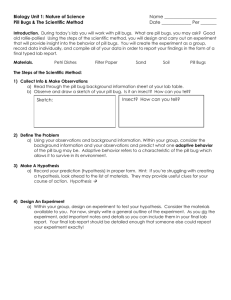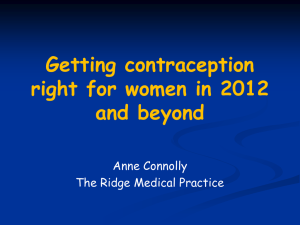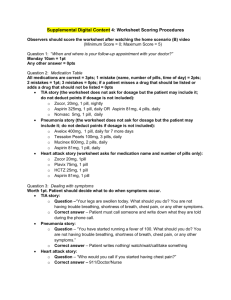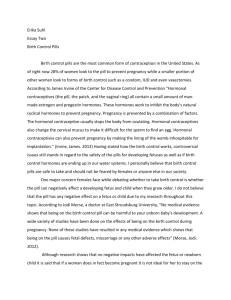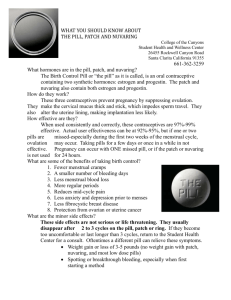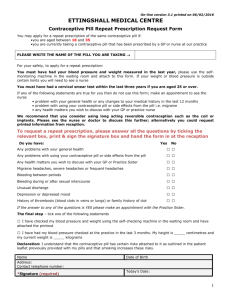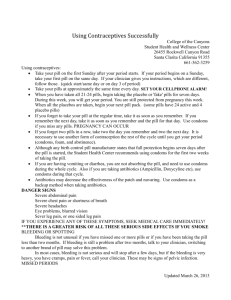The Scientific Method
advertisement
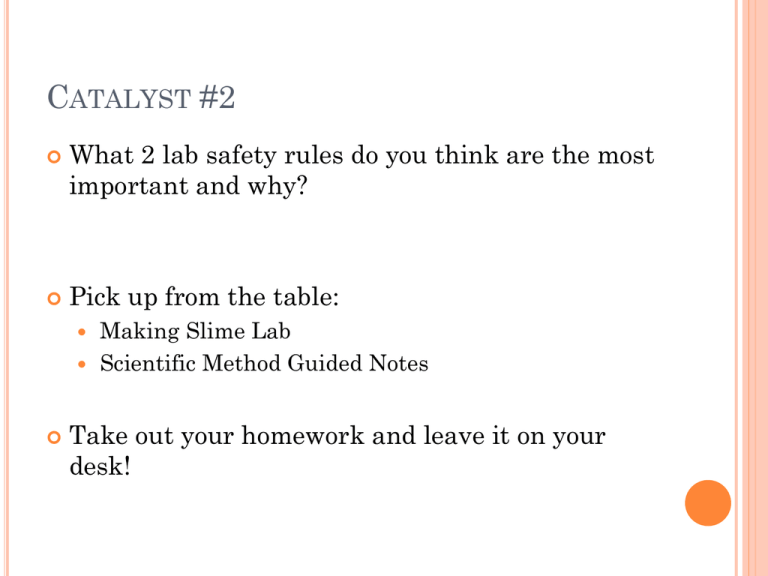
CATALYST #2 What 2 lab safety rules do you think are the most important and why? Pick up from the table: Making Slime Lab Scientific Method Guided Notes Take out your homework and leave it on your desk! AGENDA 1) 2) 3) 4) 5) Review focus Go over lab safety worksheet Making Slime Scientific Method notes Exit ticket MAKING SLIME In your lab groups, it will be your job to create slime I am specifically not telling you how to make it and as a group, you must figure it out. You will have a TOTAL of 40 minutes to complete the entire activity. You MUST have one person recording how you make it as you make it. Everyone afterwards will have to copy it onto their paper MAKING SLIME CONTINUED. When you are finished, you must clean up your area so it looks as it did before we started ANSWER question #1 before you begin working on the lab, INDEPENDENTLY THE SCIENTIFIC METHOD How do we think like a scientist? WE WILL BE ABLE TO: Understand why we use the scientific method Apply the scientific method to an experiment Demonstrate proper lab safety procedures Standard Students will identify and investigate problems scientifically. SCIENTIFIC METHOD Inquiry The search for information and explanation of that information The process of inquiry and investigation that researchers use to gain knowledge is the scientific method. We use scientific method to help us understand the world around us better. Science The word Science is derived from Latin and means “to know” SCIENTIFIC METHOD 1. Suggest reasonable hypotheses for identified problems. 2. Develop procedures for solving scientific problems. 3. Collect, organize and record appropriate data. 4. Graphically compare and analyze data points and/or summary statistics. 5. Develop reasonable conclusions based on data collected. 6. Evaluate whether conclusions are reasonable by reviewing the process and checking against other available information. STEP 1: SUGGEST REASONABLE HYPOTHESES FOR IDENTIFIED PROBLEMS. First, identify the problem Ask yourself: What am I trying to figure out? Example: You and your friend can make the same number of jump-shots in two minutes. Will your jump-shot get better if you practice? Hypothesis= educated guess A possible explanation of observations A suggested solution to a problem A possible answer to a problem If….then….. Example: I hypothesize (or guess) that if you practice more, then your jump-shot will get better. **Goal of any experiment is to prove or disprove your hypothesis.** STEP 2: DEVELOP PROCEDURES FOR SOLVING SCIENTIFIC PROBLEMS. Procedures= Steps How can I figure out how to find an answer to my question? Important Points for Procedure Conditions Variables CONDITIONS Experimental Group The condition where we change what we are testing for Example: If I am testing to see if my jump-shot will get better with practice, then my experimental condition will be practicing my jump-shot. Control Group The condition that will not change what we are testing for Example: If I am testing to see if your jump-shot will get better with practice, then my control condition will be not practicing. !!IMPORTANT!!! The only way you will be able to tell if your hypothesis is correct is if you see a difference between the experimental condition and the control condition Example: Is there a difference between the shooter that practices and the one that doesn’t? QUICK CHECK Jaquan and his twin sister Jaquita have acne. They want to see if their acne will clear up if they stop eating greasy food. They decide that Jaquita will stop eating greasy food and Jaquan will continue to enjoy his french fries and chicken fingers. Which group is the experimental (test) group? Which group is the control group? VARIABLES The ONLY things that can change in an experiment. EVERYTHING ELSE MUST BE THE SAME! INDEPENDENT VARIABLE The variable that you manipulate, or change Also called the manipulated variable What are you changing to get a result? Most common: Time, Temperature Our example: Practice DEPENDENT VARIABLE Responses or answers you get from the experiment because they DEPEND on what happens in the experiment What will you be measuring at the end of the experiment? The OUTCOME Our example: The number of jump-shots made QUICK CHECK Which is the DEPENDENT variable and which is the INDEPENDENT variable? Hypothesis: If Jamal wears baggy pants, then he will get less dates. What things are changing? Which one are we manipulating? Which one depends on what happens during the experiment? STEP 3: COLLECT, ORGANIZE AND RECORD APPROPRIATE DATA. HOW am I going to collect my data? What units am I going to use? Example: Will your jump-shot get better if you practice? How do we measure “better”? More jump-shots! A better shooter will make more jump-shots. Units= Number of jump-shots made (not how many you try to make) How do I physically collect data? Observations OBSERVATIONS Using one or more of the senses to gather information Two types Quantitative NUMBERS Example: How many jump-shots you see the shooter make Qualitative Descriptions (cannot be easily measured or counted) Example: See if the baskets “swish” in or bounce against the backboard OBSERVATION VS. INFERENCE Observation Something you gather with one or more of your senses Example: LeBron makes 90% of his jump-shots. Inference A conclusion you make based on observations Example: LeBron must just be naturally good at basketball This is NOT an observation! STEP 4: GRAPHICALLY COMPARE AND ANALYZE DATA POINTS AND/OR SUMMARY STATISTICS. Condition Average Number of Jump-Shots Practice 15 No Practice 5 STEP 4: GRAPHICALLY COMPARE AND ANALYZE DATA POINTS AND/OR SUMMARY STATISTICS. This means create a visual representation of your data so that the results are easy to see. Average Number of Jump-Shots 16 14 12 10 8 6 4 2 0 Average Number of Jump-Shots Practice No Practice STEP 5: DEVELOP REASONABLE CONCLUSIONS BASED ON DATA COLLECTED. Remember: The groups started out making the same number of jumpshots. One group practiced and the other didn’t. STEP 6: . EVALUATE WHETHER CONCLUSIONS ARE REASONABLE BY REVIEWING THE PROCESS AND CHECKING AGAINST OTHER AVAILABLE INFORMATION. Evaluate! Evaluate! Evaluate! We will practice evaluating other experiments so that we know how to evaluate our own work. The experiment has to be carefully constructed so that other scientists can replicate it to test its validity and reliability EXIT TICKET Please take out a separate sheet of paper. On top, write your name and your block # Number 1-5 1) WHAT IS A HYPOTHESIS? A.) the longest side of a traingle B.) a guess based on chance C.) an educated guess D.) the problem A drug company wants to see if their pill makes people lose weight. One group gets their weight-loss pill and the other group gets a sugar pill, or a placebo. 2) WHICH GROUP IS THE TEST GROUP? A.) the group that took the weight loss pill B.) the group that took the sugar pill C.) both groups are test groups D.) neither group is a test group 3) A drug company wants to see if their pill makes people lose weight. One group gets their weight-loss pill and the other group gets a sugar pill, or a placebo. WHICH GROUP IS THE CONTROL GROUP? A.) the group that took the weight loss pill B.) the group that took the placebo (sugar pill) C.) both groups are control groups D.) neither group is a control group 4) AT WARMER TEMPERATURES, MOLD WILL GROW FASTER ON BREAD. WHAT IS THE INDEPENDENT VARIABLE? A.) temperature B.) growth of mold C.) the bread 5) AT WARMER TEMPERATURES, MOLD WILL GROW FASTER ON BREAD. WHAT IS THE DEPENDENT VARIABLE? A.) the temperature B.) the mold C.) the bread
